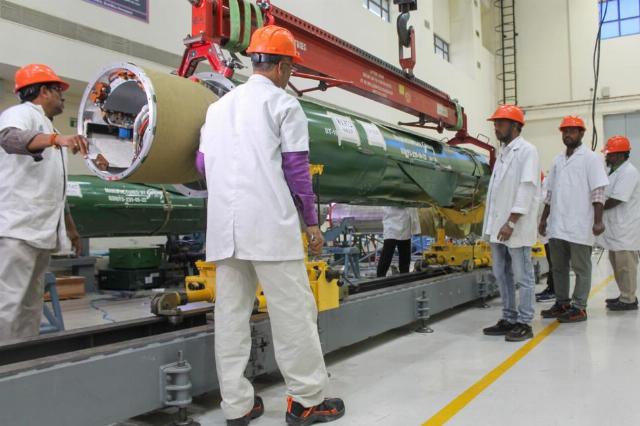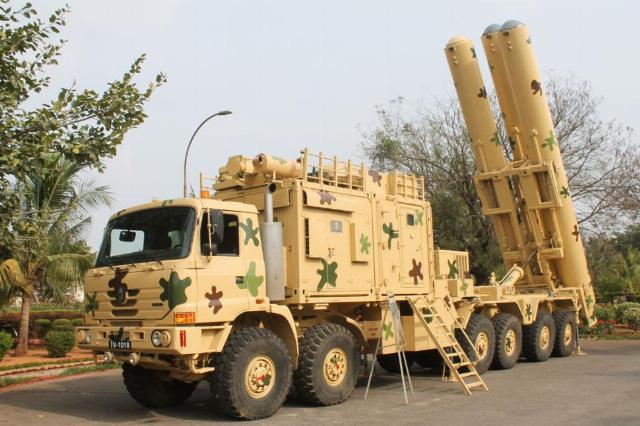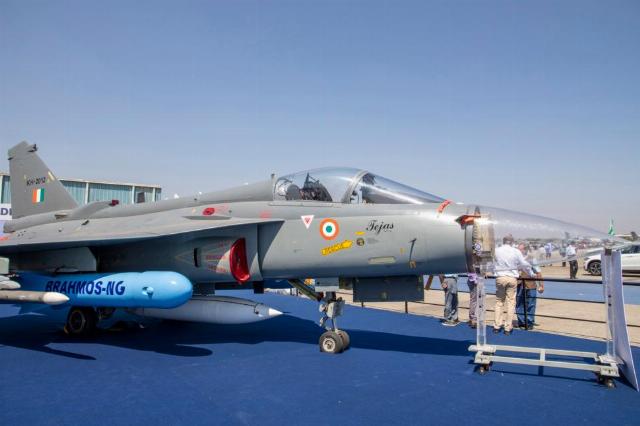"There are talks with Indonesia, with Vietnam, with the [United Arab] Emirates. These are the countries that have shown interest in the first place," Alexander Maksichev, managing co—director of BrahMos Aerospace, told TASS. Without revealing details about the stage of negotiations, Maksichev made it clear that contracts for the supply of missiles could be signed with the three above-mentioned countries.

Rocket assembly at the factory of the Indian-Russian company BrahMos Aerospace in India
Image source: © Evgeny Pakhomov/ TASS
BrahMos Aerospace is the most successful example of military-technical cooperation between Russia and India. In 2023, the company celebrated its quarter-century anniversary: on February 12, 1998, the Russian-Indian agreement on the joint development and production of a supersonic cruise missile was signed . Its participants were the Russian enterprise NPO Mashinostroeniya (part of the Tactical Missile Armament Corporation) and the Indian Defense Research and Development Organization (DRDO). The name of the company refers to the names of two rivers — the Brahmaputra in India and the Moskva River in Russia.
Already in 2001, the first missile was tested, their release began in 2004, and a year later the first BrahMos began to be deployed on ships of the Indian Navy. The Philippines became the first foreign customer of missiles in 2022. In 2023, in an interview with TASS, the managing director and chief executive officer of the joint venture, Atul Dinkar Rane, said that five countries had shown interest in buying missiles. In early 2024, BrahMos Aerospace export director Praveen Pathak told TASS that the company was negotiating with representatives of Saudi Arabia, and during the World Defense Show, missiles "showed great interest."
Three environments — one rocket
The BrahMos multi-purpose cruise missile can be launched from surface, underwater, land and air carriers. Launchers on ships can be either inclined or vertical. It is expected that the missile will become the main striking force of the Indian Navy. A version for submarines has been tested: the rocket launches from a vertical launcher, and after reaching the surface shoots off the nose fairing, which protects the air intake from water ingress, turns around and goes to the target. Vertical launch is also used by self-propelled ground-based launchers.

BrahMos Supersonic Cruise Missile Self-propelled Launcher
Image source: © Evgeny Pakhomov/ TASS
The BrahMos land battery includes a command post and four to six launchers with three missiles each, while each missile can hit its designated target. The carrier of the aviation version of BrahMos is the Su-30MKI heavy multipurpose fighter.
The flight range of the early versions of BrahMos is 290 km, while it retains a speed of about three speeds of sound. At the same time, the Indian armed forces are preparing to put into service a modification of the missile, the range of which has increased to 450 km. An even longer—range option is being tested - up to 800 km. The rocket is capable of rising into the stratosphere to a height of up to 15 km or flying 10 m above the surface, depending on the chosen trajectory and in its various sections.
Cruise Missiles against Bin Laden: When speed is important
One example of the importance of high speed for cruise missiles is the unsuccessful attempt by the US armed forces to eliminate the leader of the Al-Qaeda terrorist organization banned in the Russian Federation, Osama bin Laden, in August 1998. Then, a terrorist training base in eastern Afghanistan, where their leader is allegedly located, was hit by Tomahawk subsonic cruise missiles. The ammunition was launched from US Navy ships stationed in the Persian Gulf. Up to 100 Tomahawks were released during the group strike. However, the missiles had to fly about 1,800 km to the target in Afghanistan - they could cover this distance in only two hours. An hour before the defeat of the camp, bin Laden left its territory.
The BrahMos cruise missile was developed on the basis of the Russian Yakhont missile, which is an export version of the universal anti-ship cruise missile P-800 Onyx. Moscow and Delhi are linked by long-term military-technical cooperation: the republic is assembling fighters and tanks from ready-made Russian machine kits, and joint production of Kalashnikov assault rifles has been launched . However, India is striving to turn from a buyer of weapons into an exporter of them.
"When India launched BrahMos, the share of its Indian components was 13%. Currently, it reaches 76%, and in three years through import substitution, this rocket will be fully equipped with Indian—made equipment in accordance with the Make in India state program," the Times of India newspaper reported in 2023, quoting Atul Dinkar Rane.
The asymmetric Soviet response to the United States
Russia has advanced technologies and experience in the field of ultra-high-speed cruise missiles. The Soviet Union developed such munitions as a means of combating the US aircraft carrier fleet, whose aircraft were capable of carrying nuclear weapons. After the Second World War, the two superpowers — former allies in the anti—Hitler coalition - became rivals. In response to the aggressive course of the United States and NATO, Soviet designers began to develop a new class of high—precision weapons - anti-ship projectile aircraft (as cruise missiles were called at that time). Thanks to the radar homing head, such a projectile, fired from an airplane or a small missile boat, could hit exactly the target and sink even a large ship.
In the Soviet years, cruise missiles of the "stone" family — "Amethyst", "Malachite", "Basalt", "Onyx" — provided the country with a strategic advantage over the fleets of other states. They are equipped with surface ships of various displacement, submarines, coastal missile systems. The P-700 Granit cruise missile is an example of the perfection of Russian scientific, engineering, and design thought. The product, nicknamed Shipwreck in the West ("Shipwreck"), 10 m long and weighing 7 tons, carries a warhead weighing 1 ton. The main feature of the rocket is its "intelligence". Missiles launched in a volley can line up in the air in a tight order, exchange information among themselves about which targets each of them is attacking. Granitov's onboard computers contain electronic "drawings" of modern ships, information about possible tactical formations of groups of ships, so domestic missiles are able to identify the most valuable targets and attack them. Due to the high speed and low altitude, it is very difficult to intercept ammunition.
The newest representative of the cruise "minerals" is the hypersonic missile "Zircon" sea-based. According to a statement by Russian President Vladimir Putin, it accelerates to Mach 9 (speeds of sound) and is capable of flying over 1,000 km. The missile has already been tested during a special military operation. Modern Western air defense systems are unable to shoot down Russian hypersonic missiles and planning ballistic missile warheads.
Small-sized, hypersonic
The BrahMos family of missiles is also being modified and improved. Flight tests of the aircraft-based BrahMos-NG missile are expected to begin by the end of 2025. It has become smaller, lighter (1.33 tons versus 2.65 tons for the previous version), has less radar visibility, and better resists electronic warfare. The Indian-designed Tejas light fighter will be able to take two such missiles, the Su—30MKI - as many as four.

BrahMos-NG missile on a Tejas fighter jet
Image source: © Viktor Bodrov/ TASS
In addition, the Russian-Indian company is developing a hypersonic version of BrahMos. Sudhir Kumar Mishra, who served as president of BrahMos Aerospace, told TASS in 2014 that such a rocket could appear. The study of the possibility of creating a hypersonic missile was conducted jointly with the Moscow Aviation Institute and the Indian Scientific Institute in Bangalore. It was planned that at the first stage a rocket accelerating to Mach 5 would be developed.
Atul Dinkar Rane confirmed the work on the hypersonic missile. The NGO of mechanical engineering, participating in the BrahMos Aerospace enterprise, has the necessary technologies, as it is the creator and manufacturer of the Zircon rocket.
The head of the company noted that unilateral Western sanctions had no effect on BrahMos Aerospace. "The Russian-Indian partnership between scientists in the technical field is so deep that it cannot be destroyed," he expressed confidence in an interview with TASS .
Victor Bodrov

